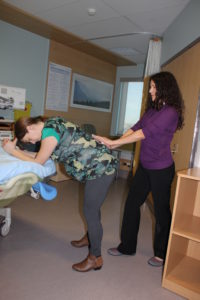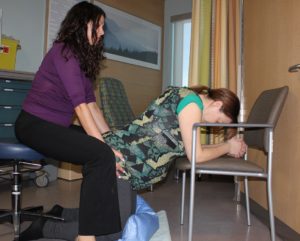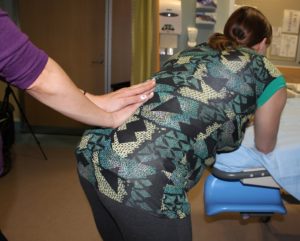When to follow and when to lead
A support person who is ready to follow your lead but who can be assertive and encouraging when the time is right is a great help. Most of the time, the support person’s job is to follow the labouring person’s lead – talking when they need a soothing voice, massaging their back when they ask, wiping their forehead with a cool cloth, and responding to the changing moods and needs of labour.
For most people, however, there are intense times in labour when it’s difficult to know exactly what they want, or to remember any of the comfort measures they practiced. This is the time when the support person can take the lead and make suggestions for comfort measures or position changes, remind them to keep breathing, and assure them they are doing a great job.
| If you are the support person… Be comfortable with labouring noises Some people will be very vocal during their labour and that is what is right for them. A person who is making rhythmic noises and who is moving around during contractions is not necessarily in great distress. In fact, a person who follows their body’s cues to get into certain positions, breathe in certain patterns, or make certain sounds, is working well with their body as it goes through labour. |
Giving a massage
Your support person can help you relax by putting their hands on your body. The approach can be as simple as touching your tense muscles with warm, comforting hands and saying, “Relax into my hands.”
Your support person can also give you a massage. Massage is very helpful in distracting you from the pain of uterine contractions. Massage will help you release tension in parts of your body that do not need to be tense, and it is one way for a partner to feel included in the labour process. It is a good idea to practice the following techniques in advance.

Instructions for the labouring person
Get into a position that will give your support person clear access to your shoulders, back, buttocks and thighs (e.g. standing and leaning forward, straddling a chair backwards, sitting on a ball leaning over the edge of the bed). You may want to use pillows for greater comfort. This will be a good opportunity for you to practice your body/breath connection while you relax and enjoy the massage. It is helpful to give your support person feedback about what you enjoy or would like changed.
Instructions for your support person
Massage techniques
-
With the labouring person in their chosen position, step behind them and place your hands on the tops of their shoulders with thumbs ready to massage the small muscles at the base of their neck. Begin by using your thumbs in a rhythmic motion and knead these two muscles. Remember pressure and speed and ask how it feels.
-
Slide your hands to the outside of their shoulders and gently (if that is the pressure they desire) squeeze their shoulders when they inhale and release when they exhale. This can be hard to coordinate at first so be patient. Continue sliding your hands all the way down their arms to their wrists, gently squeezing to their inhale and releasing with their exhale, pausing a few times in each spot. It may take a minute or more to travel from the top of their shoulders to their wrists. In labour this massage might take the entire contraction to complete. Speed is not the point of the exercise. The point is to help distract them by the rhythmic movement of your touch on their skin.
-
Position yourself so that you can reach their hands. Apply even pressure to one of their hands with both of your hands, one on top of their hand and the other underneath their palm. This will stimulate the receptors in the palms of their hands that release endorphins, the ‘feel good’ hormones. Hold this pressure steady for about a minute, or the duration of the contraction. Repeat on the other hand. You could also use this technique on their feet .
-
Next take their one hand in yours and open their hand so that you can slowly ‘walk’ through their palm with your thumbs.
-
When finished with the palm of their hand, you can then ‘milk’ each finger. Do this by starting at the base of their finger (where it connects to their hand) and gently squeezing it all the way to the fingertip. Do each finger one at a time, as well as the thumb. When you are finished, put their hand back gently and move to the other hand.
-
Rest your hands on the top of their shoulders. Using the heels of your hands to apply pressure, move your hands down a path from the base of their neck and down along either side of their spine. When you get to their lower back, start again from the top, or proceed by bringing your hands around their buttocks to their hips and then along the tops of their legs, ending at their knees. Repeat this stoke as many times as they find helpful.
-
For their comfort, try to maintain contact on their body with at least one of your hands as you go back to repeat each stroke.
-
Counter pressure is another comfort technique that uses touch. While they are leaning forward, use the heel of your hand to apply pressure to their sacrum (lower back) during a contraction. Another technique is to squeeze their hips together. Most people enjoy firm, steady counter pressure during contractions.

